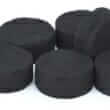Background
- Activated charcoal is a carbon-rich material that has been processed to have an increased surface area. Activated charcoal is widely used for treating drug overdoses and poisonings.
- Activated charcoal is most effective if used within one hour of ingesting toxic substances. It has proven to be effective in both adult and child overdoses of drugs such as acetaminophen, digoxin, digitoxin, tricyclic antidepressants, and barbiturates. However, activated charcoal is not effective in poisonings caused by strong acids or bases, cyanide, organic solvents, ethanol, methanol, iron, or lithium, among other substances.
- Activated charcoal has been traditionally given with laxatives to encourage removal of toxic contents and improve tolerance to charcoal. However, in 2004 and 1997, the American Academy of Clinical Toxicology and the European Association of Poisons Centres and Clinical Toxicologists stated that they do not endorse the combination of activated charcoal with a laxative. This combination may cause serious side effects such as dehydration, electrolyte imbalances, and low blood pressure.
- Activated charcoal has been studied for many stomach disorders, including diarrhea, gas, and indigestion. Research suggests that activated charcoal may benefit people who have diarrhea caused by chemotherapy. When combined with simethicone, activated charcoal may improve symptoms of indigestion. Activated charcoal may also improve bloating and stomach cramps and prevent gas.
- Due to its adsorbing effects (attracts substances to the surface of the material), activated charcoal may help treat liver and kidney disorders. Taking activated charcoal by mouth may lower cholesterol levels and reduce high levels of bile acids. Charcoal may also be given with light therapy to help prevent jaundice (yellowing of the skin) in newborn babies.
- Activated charcoal particles have been studied as a drug delivery system to improve effectiveness of therapies and reduce chemotherapy agent side effects. However, more research is needed in this area.
References
- Brahmi N, Kouraichi N, Thabet H, et al. Influence of activated charcoal on the pharmacokinetics and the clinical features of carbamazepine poisoning. Am J Emerg.Med 2006;24(4):440-443. View Abstract
- Brok J, Buckley N, and Gluud C. Interventions for paracetamol (acetaminophen) overdose. Cochrane Database.Syst.Rev. 2006;(2):CD003328. View Abstract
- Bucaretchi F and Baracat EC. [Acute toxic exposure in children: an overview]. J Pediatr (Rio J) 2005;81(5 Suppl):S212-S222. View Abstract
- Chyka PA, Seger D, Krenzelok EP, et al. Position paper: Single-dose activated charcoal. Clin.Toxicol.(Phila) 2005;43(2):61-87. View Abstract
- Coffin B, Bortolloti C, Bourgeois O, et al. Efficacy of a simethicone, activated charcoal and magnesium oxide combination (Carbosymag(R)) in functional dyspepsia: results of a general practice-based randomized trial. Clin.Res Hepatol.Gastroenterol. 2011;35(6-7):494-499. View Abstract
- Craig S. Phenytoin poisoning. Neurocrit.Care 2005;3(2):161-170. View Abstract
- Dargan PI, Colbridge MG, and Jones AL. The management of tricyclic antidepressant poisoning : the role of gut decontamination, extracorporeal procedures and fab antibody fragments. Toxicol.Rev. 2005;24(3):187-194. View Abstract
- Greene SL, Kerins M, O'Connor N. Prehospital activated charcoal: the way forward. Emerg.Med J 2005;22(10):734-737. View Abstract
- Hoegberg LC, Christophersen AB, Christensen HR, et al. Comparison of the adsorption capacities of an activated-charcoal--yogurt mixture versus activated-charcoal--water slurry in vivo and in vitro. Clin.Toxicol.(Phila) 2005;43(4):269-275. View Abstract
- Kerihuel JC. Effect of activated charcoal dressings on healing outcomes of chronic wounds. J Wound Care 2010;19(5):208, 210-208, 215. View Abstract
- Matteucci MJ, Habibe M, Robson K, et al. Effect of oral calcium disodium EDTA on iron absorption in a human model of iron overdose. Clin.Toxicol.(Phila) 2006;44(1):39-43. View Abstract
- Roberts DM, Southcott E, Potter JM, et al. Pharmacokinetics of digoxin cross-reacting substances in patients with acute yellow Oleander (Thevetia peruviana) poisoning, including the effect of activated charcoal. Ther Drug Monit. 2006;28(6):784-792. View Abstract
- Sergio GC, Felix GM, and Luis JV. Activated charcoal to prevent irinotecan-induced diarrhea in children. Pediatr Blood Cancer 2008;51(1):49-52. View Abstract
- Spiller HA, Winter ML, Klein-Schwartz W, et al. Efficacy of activated charcoal administered more than four hours after acetaminophen overdose. J Emerg.Med 2006;30(1):1-5. View Abstract
- Stass H, Kubitza D, Moller JG, et al. Influence of activated charcoal on the pharmacokinetics of moxifloxacin following intravenous and oral administration of a 400 mg single dose to healthy males. Br J Clin.Pharmacol. 2005;59(5):536-541. View Abstract







